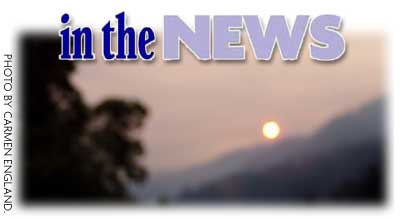|
|
 Sticks and stones |
Culture Citation Fog of War |
Books and hills on fire
by HEIDI WALTERS
"An evacuation of 10-14 homes along the North Fork of the Trinity from Hobo Gulch South to Helena has been ordered by officials. The communities of Big Flat and Helena remain under a voluntary evacuation order. In addition the communities of Del Loma, Big Bar, and Denny are also threatened. Highway 299 remains open, subject to delays." -- from a Sept. 12 update on the Bar Complex wildland fire, posted on InciWeb (www.inciweb.org), a wildland fire and incident information website.
In mid-July, a lightning storm moved across Northern California's inland mountain region, sparking fires in several national forests and wilderness areas. Over the ensuing weeks, many of the fires merged. Some fires since have been put out. And as of this Tuesday, in our neck of the woods, firefighters had a strong line around only one of the remaining ones: the Orleans Complex, in the Six Rivers National Forest, which had burned 15,710 acres and was 95 percent contained. Two others -- the Uncles Complex in the Klamath National Forest (21,479 acres burned) and the Bar Complex (48,796 acres burned) in the Shasta-Trinity National Forest were each 50 percent contained.
The Bar Complex, where currently 1,041 firefighters are engaged, is indeed complex: It includes the Bake Oven Fire, started by the lightning and burning in the Trinity Alps Wilderness where firefighting is limited by law to Minimum Impact Suppression Tactics (no bulldozers allowed), and the Pigeon Fire, started over Labor Day weekend and being investigated as human-caused. The Pigeon initially prompted closure of Highway 299, and the Sept. 12 incident update notes there is low visibility caused by an inversion layer trapping smoke in the valleys, as well as problems with "[r]olling fire brands [that] continue to occur on the Road to Hobo Gulch." The plan of attack was to keep stapling "cabin wrap" -- a fire-resistance material -- to structures and clear brush around them and remove powerlines in the fire's path.
Fire fighters estimate they'll have the Bar Complex contained by Sept. 30 at "1800 hours." Fighting it has cost, to date, $7.4 million for the Pigeon fire and $23.1 million for the Bake Oven.
Meanwhile, over in Shasta-Trinity headquarters in Redding, the phone has been ringing. And ringing. "I get calls every day from people asking, `Why are you letting this fire burn?'" said public affairs officer Mike Odle on Friday. "And they say, `If CDF was on this fire, it'd be out by now.' But, the thing is, we do have the California Department of Forestry as a collaborator" fighting the fire. "But I appreciate their calling -- at least they do have an interest in their forest."
Odle says he's been getting two to three calls a day like that ever since the fires started -- and when the smoke is trapped by an inversion layer, the number of calls goes up. And, despite the latest incident update, Odle suspects "we'll see this fire through October. The Pigeon Fire -- there's eight miles of line to be dug around it, down to mineral soil -- that's a lot of miles. And the Pigeon Fire is only 5,000 acres. Compare that with the Bake Oven, which is about 30,000 acres -- how many miles of line around it will that take?" He doesn't know the answer off hand, but says, again, "That's a lot of line."
As incident commanders like to say in the news releases they dash off regularly to the media, this may be one of those fires that likely "will burn till the snow falls." But that does not -- repeat, does not -- mean the Forest Service is just "letting it burn." In fact, say the words "let it burn" within earshot of any of our region's forest service offices, and you'll likely ignite a small, fiery outburst of disgust.
"No one in the forest service has a `let it burn' policy," Jaime Tarne, with the Klamath National Forest, said last week. "That's a media nomenclature, and it's incorrect. We look at how threatening the fire is, where it is, how easy or difficult it is to get to," and devise a strategy from there. "But we never walk away from a fire and `let it burn.' We always watch them, monitor them. We have a strategy: `This is as far as we'll let it go.'" She sighs, adds, "I've been fighting that [let-it-burn mythology] for so many years!"
Peggy Lawrence, with the Six Rivers National Forest, likewise recoiled at the question. "Our forest plan doesn't have a let-it-burn philosophy," she said.
The let-it-burn nomenclature was bandied about with extra fury after the 1988 Yellowstone National Park fire, a combination of prescribed fires and naturally sparked fires that consumed vast acreages. Some people accused the forest service of taking the so-called "let it burn" philosophy too far -- a philosophy, misunderstood some say, that in itself was a reaction to an emerging sense that nearly 80 years of fire suppression across the country had led to incredibly flammable wildlands. What has transpired in the last 10 years, say forest managers, is a national fire policy that prescribes an "appropriate management response" to distinct zones within a forest. In some cases, the strategy might indeed be to monitor a fire and confine it to a certain area, especially if that area could use a little clearing out.
"We do not use, at this time, naturally caused fire for wildland benefit use," said Odle with the Shasta-Trinity. "We haven't moved to that yet -- we are exploring its possible use in the Trinity Alps Wilderness." But that change will come slowly.
If the forest service had followed a so-called let-it-burn-and-monitor-it strategy on the Bar Complex, Odle said, as an example, "based on our fire modeling, it would have burned 250,000 acres. And it would have burned structures and across forest boundaries, and over traditional ancient Hupa and other Native American lands. We had over 1,300 fire fighters on this fire. When you go to `wildland fire use for resource benefit,' we probably would have only had 85 fire fighters on it, monitoring the fire and keeping it within a safety zone."
How the different national forests fight fires depends on their particular geography -- and within each forest the geography can vary wildly enough to where a fire fighting strategy may differ from drainage to drainage. "Here on the Klamath, fires used to burn an average of every 12 years," before suppression began sometime after World War II when the first roads were built," said Maxine Kolu with the Klamath National Forest. "The forest was so cleaned up, that the fires never got that bad." In contrast, on the coast fires historically have gone through every 80 to 100 years -- so, active fire suppression since the early 1900s hasn't made that big of a difference there.
Jay Kirchner, with Klamath N.F., added that under the Northwest Forest Plan, each forest has had to devise a land management plan, and within that a fire plan, that reads much like a city planning guide, with different goals and treatments for different zones, such as wilderness, commercial timber lands, riparian reserves, scenic and recreational lands, wildland-urban interface lands and late-successional reserves set aside for threatened and endangered species. "And most of what we do when we're picking our tactics [for fire fighting] is for safety," Kirchner said. "But every fire we currently have, we are working to suppress."
It is an ever-shifting thing, this arena of fire fighting. Some Native Americans used fire to manage the land -- to clear it so grass, for baskets, could grow; to create open spaces; to encourage acorn tree growth. European Americans, in the 1900s, developed a fear of wildfires and began suppressing them. Today, the thinking has changed yet again, to where fire is again not considered always to be "bad."
Two books coming out later this year deal with this very topic -- how we perceive wildfire, and how we deal with it. WILDFIRE: A Century of Failed Forest Policy, is a multi-authored account edited by George Wuerthner. It takes a polemical approach and, physically, promises to be one of Wuerthner's typical gigantic, large-photo-rich, heavy volumes that, presumably, could be used to wallop sense into the reader if the text itself doesn't do it. The book examines a variety of federally sanctioned practices on public lands, among them: logging that takes the most fire-resistant trees and leaves spindly frail forests at the mercy of wildfires; livestock grazing that encourages more tree growth where grass used to be, and grazing that encourages, conversely, the growth of the invasive cheatgrass -- which burns fast and often; and rural sprawl.
"I expect we're going to see more and more big fires," Wuerthner said from his home in Oregon last Friday. He says there are nuances in each forest. But he concludes: "We're putting all of these resources into stopping big fires, and it doesn't work. I think we should let the huge fires burn, and put a perimeter around them to protect the towns. And, they should spend more money upfront and focus on making communities fireproof, and on building codes."
The other book, Fire in California's Ecosystems, takes an academic approach and also has numerous authors. Co-editor Kevin Shaffer, who works for the California Department of Fish and Game, conceived of the book 10 years ago when the woods were ablaze, the public was screaming, and academics and agencies were trying to hash out what to do. The book covers the science of fire; how fire occurs across the state from bioregion to bioregion; and how people have dealt with fire over time: from how Native Americans used fire, to how fire affects endangered species and air quality, to how it interacts with invasive species, and more. Today, said Shaffer, "we are in the midst of deciding what changes we're making" in fire management. "We're finally starting to understand how fire works and what our relationship to it is."
HSU Professor John Stuart co-wrote Chapter 8 of the book, which covers the North Coast Bioregion (including Six Rivers National Forest). It's as diverse a region as one can hope for, both historically and geographically -- and where, incidentally, the second highest incidence of lightning strikes occurs, next to Riverside County. Stuart says the underlying message the book imparts is that fire policy is a moving target -- and what we decide to do about managing our forests becomes a value judgment. The trick is, do we base the decision on what we know, or on what happened far in the past, or on some other criteria?
"I think we have to keep in mind that these things evolve," he said. "The role of fire changes over time, climate changes, technology changes and human use of fire changes. The thing that concerns me is, the decision makers may be looking for simplistic solutions to what is a complex problem."
COVER STORY | IN THE NEWS | FROM THE PUBLISHER | OFF THE PAVEMENT
TALK OF THE
TABLE | THE HUM | CALENDAR
Comments? Write a letter!
© Copyright 2006, North Coast Journal, Inc.

